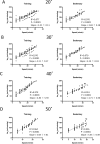Fat max as an index of aerobic exercise performance in mice during uphill running
- PMID: 29474428
- PMCID: PMC5825145
- DOI: 10.1371/journal.pone.0193470
Fat max as an index of aerobic exercise performance in mice during uphill running
Abstract
Endurance exercise performance has been used as a representative index in experimental animal models in the field of health sciences, exercise physiology, comparative physiology, food function or nutritional physiology. The objective of the present study was to evaluate the effectiveness of Fatmax (the exercise intensity that elicits maximal fat oxidation) as an additional index of endurance exercise performance that can be measured during running at submaximal exercise intensity in mice. We measured both Fatmax and Vo2 peak of trained ICR mice that voluntary exercised for 8 weeks and compared them with a sedentary group of mice at multiple inclinations of 20, 30, 40, and 50° on a treadmill. The Vo2 at Fatmax of the training group was significantly higher than that of the sedentary group at inclinations of 30 and 40° (P < 0.001). The running speed at Fatmax of the training group was significantly higher than that of the sedentary group at inclinations of 20, 30, and 40° (P < 0.05). Blood lactate levels sharply increased in the sedentary group (7.33 ± 2.58 mM) compared to the training group (3.13 ± 1.00 mM, P < 0.01) when running speeds exceeded the Fatmax of sedentary mice. Vo2 at Fatmax significantly correlated to Vo2 peak, running time to fatigue, and lactic acid level during running (P < 0.05) although the reproducibility of Vo2 peak was higher than that of Vo2 at Fatmax. In conclusion, Fatmax can be used as a functional assessment of the endurance exercise performance of mice during submaximal exercise intensity.
Conflict of interest statement
Figures








Similar articles
-
Positive effect of exercise training at maximal fat oxidation intensity on body composition and lipid metabolism in overweight middle-aged women.Clin Physiol Funct Imaging. 2016 May;36(3):225-30. doi: 10.1111/cpf.12217. Epub 2014 Nov 19. Clin Physiol Funct Imaging. 2016. PMID: 27072372 Clinical Trial.
-
Limited benefit of Fatmax-test to derive training prescriptions.Int J Sports Med. 2014 Apr;35(4):280-5. doi: 10.1055/s-0033-1349106. Epub 2013 Sep 10. Int J Sports Med. 2014. PMID: 24022578
-
Effect of speed endurance and strength training on performance, running economy and muscular adaptations in endurance-trained runners.Eur J Appl Physiol. 2016 Jul;116(7):1331-41. doi: 10.1007/s00421-016-3356-4. Epub 2016 May 14. Eur J Appl Physiol. 2016. PMID: 27179795 Clinical Trial.
-
The physiology of deep-water running.J Sports Sci. 2003 Dec;21(12):959-72. doi: 10.1080/02640410310001641368. J Sports Sci. 2003. PMID: 14748454 Review.
-
Assessment of maximal fat oxidation during exercise: A systematic review.Scand J Med Sci Sports. 2019 Jul;29(7):910-921. doi: 10.1111/sms.13424. Epub 2019 Apr 21. Scand J Med Sci Sports. 2019. PMID: 30929281
Cited by
-
Disrupting AMPK-Glycogen Binding in Mice Increases Carbohydrate Utilization and Reduces Exercise Capacity.Front Physiol. 2022 Mar 22;13:859246. doi: 10.3389/fphys.2022.859246. eCollection 2022. Front Physiol. 2022. PMID: 35392375 Free PMC article.
-
Cardioprotection of voluntary exercise against breast cancer-induced cardiac injury via STAT3.Basic Res Cardiol. 2025 Feb;120(1):113-131. doi: 10.1007/s00395-024-01076-8. Epub 2024 Aug 19. Basic Res Cardiol. 2025. PMID: 39158697
-
d-Allulose Improves Endurance and Recovery from Exhaustion in Male C57BL/6J Mice.Nutrients. 2022 Jan 18;14(3):404. doi: 10.3390/nu14030404. Nutrients. 2022. PMID: 35276765 Free PMC article.
-
Acute Administration of Exogenous Lactate Increases Carbohydrate Metabolism during Exercise in Mice.Metabolites. 2021 Aug 21;11(8):553. doi: 10.3390/metabo11080553. Metabolites. 2021. PMID: 34436494 Free PMC article.
-
Reliability of blood lactate as a measure of exercise intensity in different strains of mice during forced treadmill running.PLoS One. 2019 May 3;14(5):e0215584. doi: 10.1371/journal.pone.0215584. eCollection 2019. PLoS One. 2019. PMID: 31050686 Free PMC article.
References
-
- Astrand PO. Quantification of exercise capability and evaluation of physical capacity in man. Prog Cardiovasc Dis. 1976;19: 51–67. - PubMed
-
- Lechner AJ. The scaling of maximal oxygen consumption and pulmonary dimensions in small mammals. Respir Physiol. 1978;34:29–44. - PubMed
-
- Ayachi M, Niel R, Momken I, Billat VL, Mille-Hamard L. Validation of a ramp running protocol for determination of the true VO2max in mice. Front Physiol. 2016;7: 372 doi: 10.3389/fphys.2016.00372 - DOI - PMC - PubMed
-
- Kemi OJ, Loennechen JP, Wisloff U, Ellingsen O. Intensity-controlled treadmill running in mice: cardiac and skeletal muscle hypertrophy. J Appl Physiol (1985). 2002;93: 1301–1309. - PubMed
-
- Petrosino JM, Heiss VJ, Maurya SK, Kalyanasundaram A, Periasamy M, LaFountain RA, et al. Graded maximal exercise testing to assess mouse cardio-metabolic phenotypes. PLoS One. 2016;11: e0148010 doi: 10.1371/journal.pone.0148010 - DOI - PMC - PubMed
Publication types
MeSH terms
LinkOut - more resources
Full Text Sources
Other Literature Sources

